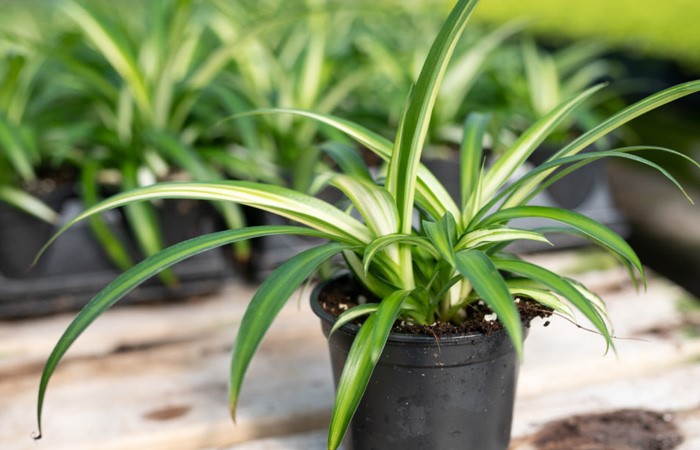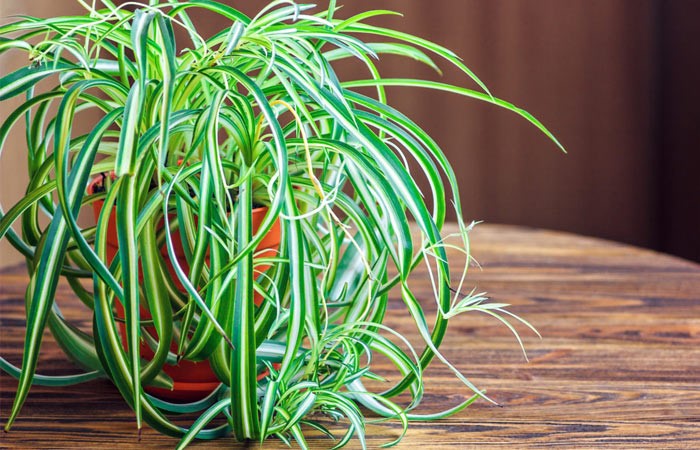Spider Plant Grow and Care Guide

When you hear the name spider plant, do you think of the notorious arachnid, or one of the most adaptable and popular houseplants? Being one of the easiest houseplants to grow, you can easily find spider plant in your friends and families houses.
Since you can grow this stunning plant in a wide range of conditions, it’s an excellent choice for a houseplant. In this article, we are going to discuss spider plant varieties, spider plant propagation and practical tips for spider plant care.
Spider Plant Varieties
Scientifically named Chlorophytum and native to South Africa, spider plant has different varieties. People also call them “spider ivy,” “ribbon plant,” and “airplane plant.” Below, you’ll find some of the most popular spider plant varieties.
1. Zebra
Zebra is fast-growing spider plant with yellow edges that will turn white, giving it an icy appearance. Among spider plant varieties, you can grow zebra plant in a hanging basket or as ground cover. Zebra variety grows best in full sunlight to partial shade.
2. Bonnie
If you want a curly spider plant, bonnie or “toilet plant” would be the best choice. Spider plant care for bonnie and its bright and narrow leaves is easy as well. Since its leaves can grow up to 18 inches, bonnie is perfect for small rooms, bathrooms, and balconies. Bonnie also has beautiful yellow flowers.
3. Vittatum
Among spider plant varieties, Vittatum is the most popular. The drought-tolerant and perennial Vittatum has off-white stripes on its slightly curved green leaves. Growing up to 2 feet long, you can grow this evergreen spider plant under light shade in well-draining soil.
4. Hawaiian
The fascinating Hawaiian spider plant or “Golden Glow”, is a small variety with shiny green leaves. You can grow Hawaiian spider plants in moist and well-draining soil in direct sunlight to partial shade. In such condition, it can grow up to 12 inches long.
5. Variegatum
Variegatum is another popular spider plant variety. The curved leaves of Variegatum have white edges and dark green stripe in the center, contrasting the Vittatum. This spider plant looks amazing in living rooms and offices.

Spider Plant Propagation and Repotting
Similar to spider plant care that we’ll review later, spider plant propagation is simple as well. All you need to do is to pot the small plantlets or “spiderettes” (baby spider plants) with developed roots.
Another option is to cut one of the baby spider plants off, place it in a suitable pot, and water generously. Next you need to put the pot in a ventilated plastic bag and place it in a bright environment. When the plantlet is rooted, you can remove the new spider plant from the bag and grow it normally.
Tip: You don’t need to repot spider plant varieties every year. When the plant root ball peeks above the rim of the pot, it is time to repot it.
For more information, read this article: how to repot a cactus
Spider Plant Care Tips
To care spider plant outdoors or indoors, you should know the important tips for caring this beautiful plant.
Water
During the initial growth, you should water spider plant occasionally. Within one year and when fully developed, water well. Remember not to let spider plant become soggy to avoid root rot. If you noticed brown tips, use filtered water or sit the water overnight before watering. Browning leaf tips are caused by the chemicals in water.
Light
While spider plant varieties grow strongest in bright indirect light, they also tolerate lower light conditions. If you keep spider plant outdoors in direct sunlight, its leaves will burn. We recommend to keep it in a place with indirect lighting, where the leaves stripes will be more glossy and prominent.
Fertilizing
Fertilize your spider plant once or twice a month in the spring and summer, making sure the soil is damp before applying it. You don’t need to fertilize in the autumn or winter. Also remember that over-fertilization can lead to brown leaf tips.
Temperature and Humidity
When it comes to spider plant care indoors, average room temperature and humidity is the best. This plant prefer temperatures between 60 and 80°F during the day and above 55°F at night. If the environment is too dry for your spider plant, you will notice it by brown leaf tips. To avoid this problem, mist the plant regularly.

Spider Plant Pests and Diseases
Although spider plant varieties are safe and non-toxic for humans and pets like dogs and cats, but there are a few insects that can make the situation unsafe for the plant itself. Aphids, whiteflies, mealy bugs, and spider mites are the most common pests that attack your tough plant.
Regarding aphids and spider mites, rinsing the plant with water is effective against them. But to combat spider mites, rubbing the plant down with a miticide is a better solution. Other spider plant pests will perish by using an insecticides.
If you have pets or children and prefer a chemical-free solution, you can always try a completely natural insecticide first. For example, you can prepare an all-natural insecticides at home using some vinegar and water.
Spider Plant Brown Tips
Spider plant leaves browning is one of the common problems of thief houseplant. If you notice the leaf tips browning, don’t worry. As we said, it is completely normal and will not harm your plant. Spider plant leaves browning is often because of fluoride in water that you use for watering it.
The fluoride causes the salt to build up in the pot. Draining the plant every now and then by giving it a thorough watering to rinse excess salts is helpful is this situation. Remember to let the water drain out and do it again if necessary. Using filtered water is also a good option to avoid this common problem.
How Long Do Spider Plants Live?
Keeping the spider plant care tips in mind, these lovely plants can live up to twenty years! The long age of this evergreen plant is another reason that makes it a great choice for a houseplant.
- In this post:
- Spider Plant Varieties
- Spider Plant Propagation and Repotting
- Spider Plant Care Tips
- Spider Plant Pests and Diseases
- Spider Plant Brown Tips
- How Long Do Spider Plants Live?



